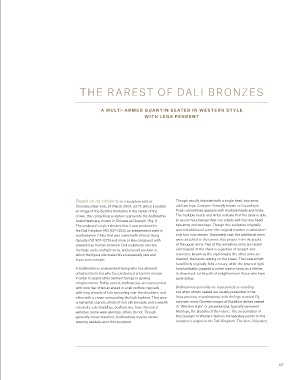Page 129 - Christie's Irving Collection Lacquer Bronse jade and Ink March 2019
P. 129
THE RAREST OF DALI BRONZES
A M U LT I -A R M E D G UA N Y I N S E AT E D N W ES T E R N S T Y L E
I
W I T H L EG S P E N D E N T
Based on its similarity to a sculpture sold at Though usually depicted with a single head, two arms,
Christie’s, New York, 24 March 2004, lot 77, which included and two legs, Guanyin—formally known as Guanshiyin
an image of the Buddha Amitabha in the center of the Pusa—sometimes appears with multiple heads and limbs.
crown, this compelling sculpture represents the bodhisattva The multiple heads and limbs indicate that the deity is able
Avalokiteshvara, known in Chinese as Guanyin. (Fig. 1) to assist more beings than can a deity with but one head,
The sculpture’s style indicates that it was produced in two arms and two legs. Though this sculpture originally
the Dali Kingdom (AD 937–1253), an independent state in sported additional arms—the original number is unknown—
southwestern China that was coeval with China’s Song only four now remain. Separately cast, the additional arms
dynasty (AD 907–1279) and more or less congruent with were attached to the tenons that project from the backs
present-day Yunnan province. Dali sculptures are rare; of the upper arms. Two of the remaining arms are raised
the large scale, multiple arms, and unusual position in and clasped at the chest in a gesture of respect and
which the fgure sits make this an especially rare and reverence known as the anjalimudra; the other arms are
important example. lowered, the hands resting on the knees. The lowered left
hand likely originally held a rosary, while the lowered right
A bodhisattva is a benevolent being who has attained hand probably grasped a coiled rope or lasso as a lifeline
enlightenment but who has postponed entry into nirvana to draw back to the path of enlightenment those who have
in order to assist other sentient beings in gaining gone astray.
enlightenment. Richly attired, bodhisattvas are represented
with long hair often arranged in a tall coifure, typically Bodhisattvas generally are represented as standing
with long strands of hair cascading over the shoulders, and but when shown seated are usually presented in the
often with a crown surrounding the high topknot. They wear lotus position, or padmasana, with the legs crossed. By
ornamental scarves, dhotis of rich silk brocade, and a wealth contrast, most Chinese images of Buddhist deities seated
of jewelry. Like Buddhas, bodhisattvas have distended in “Western style”, or paryankasana, typically represent
earlobes; some wear earrings, others do not. Though Maitreya, the Buddha of the Future. The presentation of
generally shown barefoot, bodhisattvas may be shown this Guanyin in Western fashion immediately points to this
wearing sandals, as in this sculpture. sculpture’s origins in the Dali Kingdom. The alert, fully open,
127

